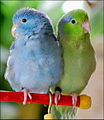Pacific parrotlet
| Pacific parrotlet | |
|---|---|

| |
| in Ecuador | |
| Scientific classification | |
| Domain: | Eukaryota |
| Kingdom: | Animalia |
| Phylum: | Chordata |
| Class: | Aves |
| Order: | Psittaciformes |
| Family: | Psittacidae |
| Genus: | Forpus |
| Species: | F. coelestis
|
| Binomial name | |
| Forpus coelestis (Lesson, 1847)
| |
The Pacific parrotlet (Forpus coelestis), also known as Lesson's parrotlet or the celestial parrotlet, is a species of small parrot in the family Psittacidae.
Description

Pacific parrotlets are small, olive green parrotlets. They are 11–14 centimetres (4.3–5.5 in) long and typically weigh 1.1–1.12 ounces (31–32 g).[2] Wild Pacific parrotlets have olive green and grey bodies with blue streaks behind the eyes, just above their ear covert feathers and around the back of the head. Eyes are dark brown, and beaks and feet are light peach. This species demonstrates sexual dimorphism: males have a bright cobalt rump with blue patches on the tail and undersides of their wings as well as lighter, yellow-green faces. Females are mostly green with much duller blue patches behind the eyes and no cobalt rump or blue in their wings. These dimorphic color variations are true of most color mutations as well. Like all parrots, Pacific parrotlets exhibit zygodactyly, meaning two toes face forward and two face backward.
In captivity there are many color mutations of Pacific parrotlets. These mutations include: blue, American yellow, American white, European yellow, white, lutino, and albino, as well as other, rarer colors. There are dilute, pied, freckled, marbled, cinnamon, and fallow versions of many these mutations as well.
Distribution and Habitat
Wild Pacific parrotlets are native to western Ecuador and northwestern Peru.[2][3] Most common in dry habitats such as the desert and deciduous forest, but have spread into humid areas in response to deforestation. [4] Pacific parrotlets have also been reported in the middle Marañón valley.[3] In 2014 a small flock of Pacific parrotlets was reported near the Rio Mataje in Nariño, southwestern Colombia.[3]
They are abundant across their range; populations are relatively undisturbed by human activity.[5] Pacific parrotlets are found living in flocks from 40 to 50, on the borders of W lowlands and foothills, woodlands, shrubby clearings, gardens, parks, and crops (Restall & Freile, 2019, p. 208). [6] Pacific parrotlets typically live in subtropical or tropical dry forest, subtropical or tropical moist lowland forest, subtropical or tropical dry shrubland, and heavily degraded former forest. Pacific parrotlets are non-migratory, meaning they stay in the same area year-round.[2]
Conservation
The Pacific parrotlet is currently listed as Least Concern by the IUCN Red List.[1] The number of mature individuals in the wild is not known, but population size seems to be stable.
Behavior

Social
Pacific parrotlets are found living in flocks from 40 to 50 (Restall & Freile, 2019, p. 208). [8] Calls are high-pitched and rapid "tchit"; in flock situations this produces a constant chattering. [9] [10]
Reproduction
Pacific parrotlets are very protective of their eggs and chicks. Each clutch has 4-6 white eggs, which are incubated for an average of 18 days. In the wild they nest in tree cavities or on fence posts.[2] They have also been observed to nest in abandoned nests of necklaced spinetails and pale-legged horneros.[5]
Diet
Pacific parrotlets tend to feed on berries and cactus fruits, but are not picky in their feeding.[5] In captivity, parrotlets eat many fruits, seeds, vegetables, and herbs.[2]
Aviculture
This species is not very common in pet stores and is valued by breeders. Its normal price range is $150–200 USD. Since 1930 the U.S. has had an established breeding population in captivity, before CITES laws preventing importing wildlife from foreign countries. In the wild, the average lifespan for Pacific parrotlets is 10.4 years.[11] Captive Pacific parrotlets can be expected to live up to 25 years[2] with good care and regular veterinary examinations, although individuals may have shorter or longer life spans.
Pacific parrotlets, like many larger parrot species, can learn to "speak," or mimic, though their "voices" are not as clear as larger birds. Their vocabulary is relatively limited compared to larger parrots.
The species is well known among parrotlet breeders and owners as being feisty and curious despite their small size.[12]
-
Female blue and male green/wild-type
-
Male yellow mutation
-
Male wild-type and female American white/dilute blue
-
Two male wild-types
-
Female wild-type
References
- ^ a b BirdLife International (2012). "Forpus coelestis". IUCN Red List of Threatened Species. 2012. Retrieved 26 November 2013.
{{cite journal}}: Invalid|ref=harv(help) - ^ a b c d e f "Celestial or Pacific Parrotlet, Lesson's Parrotlet, Forpus coelestis | Beauty of Birds". www.beautyofbirds.com. Retrieved 2019-03-08.
- ^ a b c Brinkhuizen, D.M.; Seimola, T. (October 2014). "First record of Pacific Parrotlet Forpus coelestis in Colombia" (PDF). Conservación Colombiana. 21: 30–32.
- ^ Collar, N., P. F. D. Boesman, and G. M. Kirwan (2020). Pacific Parrotlet (Forpus coelestis), version 1.0. In Birds of the World (J. del Hoyo, A. Elliott, J. Sargatal, D. A. Christie, and E. de Juana, Editors). Cornell Lab of Ornithology, Ithaca, NY, USA. https://doi.org/10.2173/bow.pacpar2.01
- ^ a b c "Pacific Parrotlet - Introduction | Neotropical Birds Online". neotropical.birds.cornell.edu. Retrieved 2019-03-11.
- ^ Restall, R. L., & Freile, J. F. (2019). Birds of Ecuador. London: Helm.
- ^ https://ebird.org/map/pacpar2?env.minX=-82.0836340238823&env.minY=-17.0033684151375&env.maxX=-71.303850614448&env.maxY=2.23102405692696
- ^ Restall, R. L., & Freile, J. F. (2019). Birds of Ecuador. London: Helm.
- ^ https://www.parrots.org/encyclopedia/pacific-parrotlet
- ^ Schulenberg, T., Stotz, D., Lane, D., Neill, J., Parker, T. & Egg. (p. 172, 2010). Birds of Peru : Revised and Updated Edition. Princeton: Princeton University Press.
- ^ https://eol.org/pages/1178011
- ^ "They May Be Small, But Parrotlets Have a Big Bird Personality". The Spruce Pets. Retrieved 2019-03-08.






